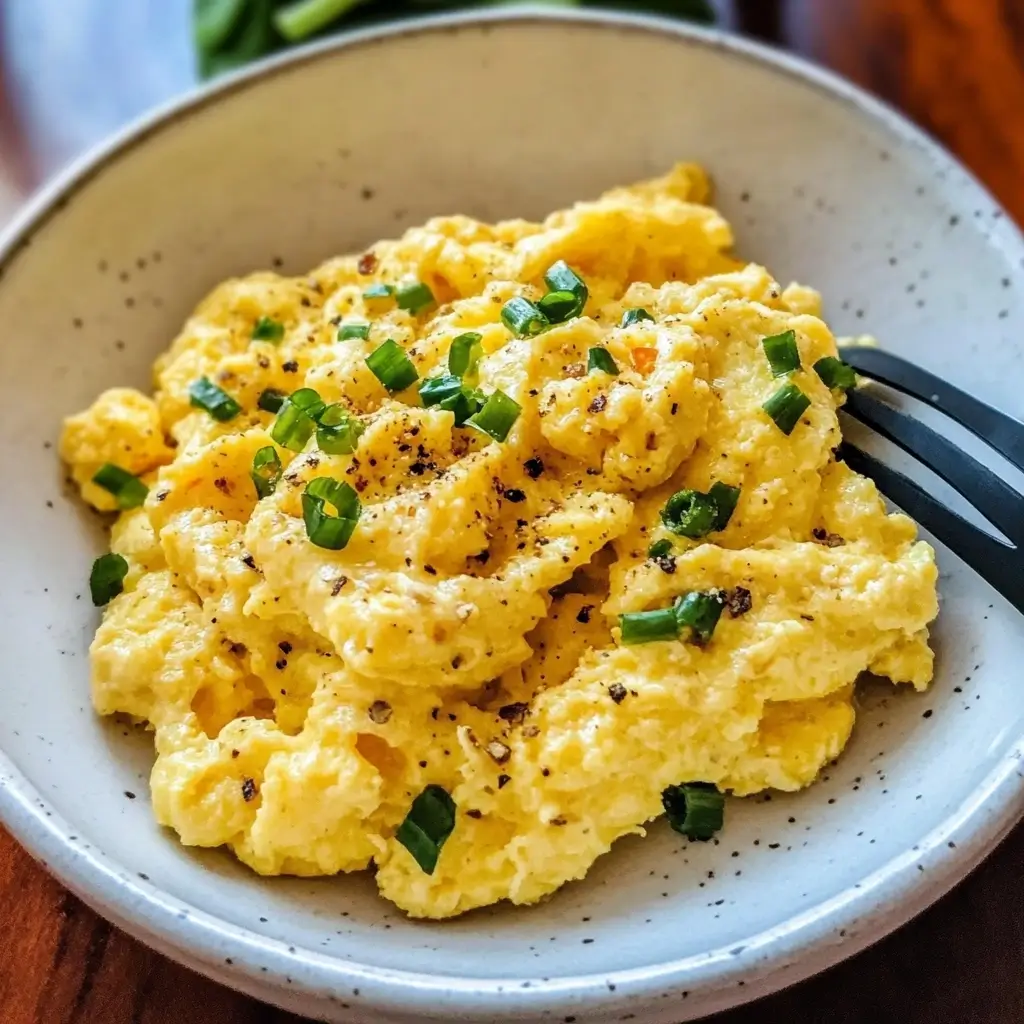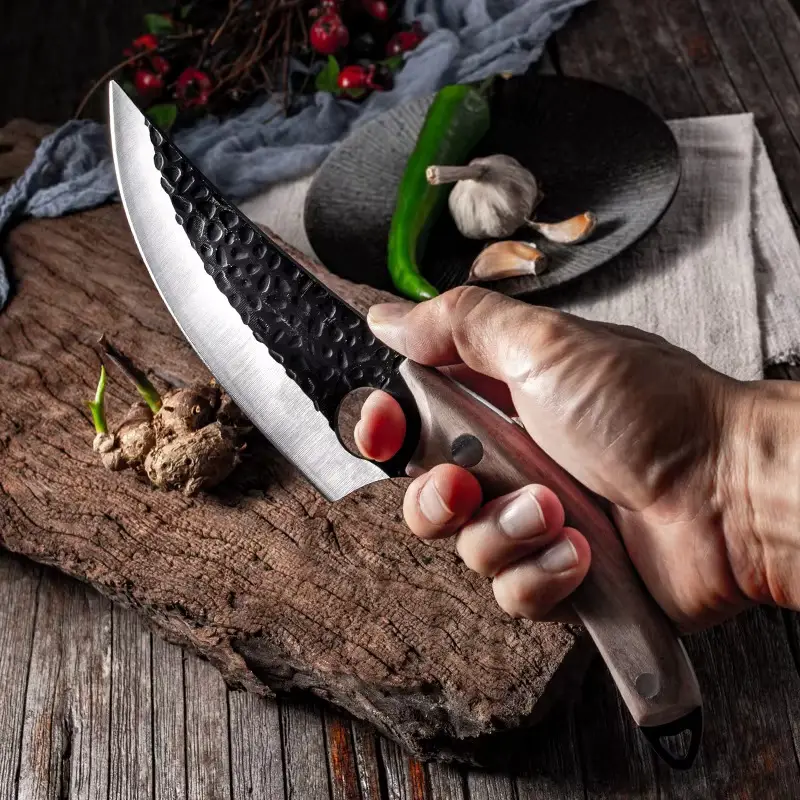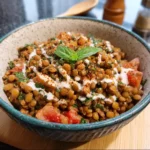In our house, breakfast is often a chaotic affair. Mornings are a whirlwind of school runs, work deadlines, and the general hustle of family life. Finding a breakfast that is both quick, nutritious, and actually enjoyed by everyone can feel like searching for a mythical creature. That’s where these high-protein scrambled eggs came to the rescue. Initially, I was skeptical – could something so simple be truly satisfying and keep us going until lunchtime? The answer, emphatically, is YES! From my protein-conscious teenager to my always-hungry husband, and even my picky-eater youngest, these scrambled eggs were a hit. They’re fluffy, flavorful, and incredibly versatile, making them a regular feature on our breakfast (and sometimes even dinner!) table. What I love most is how easily customizable they are; you can throw in whatever veggies or cheese you have on hand, and they always turn out delicious. If you’re looking for a breakfast game-changer that’s packed with goodness and guaranteed to please, look no further – these high-protein scrambled eggs are about to become your new morning staple.
Ingredients for High-Protein Scrambled Eggs
- Eggs (4 large): The foundation of our dish, providing a complete protein source and rich in essential nutrients. Choose free-range or organic eggs for the best flavor and quality.
- Egg Whites (4 large): Adding extra egg whites boosts the protein content significantly while keeping the fat and cholesterol relatively lower. They also contribute to a lighter, fluffier texture.
- Cottage Cheese (1/4 cup, full-fat or low-fat): A secret weapon for creamy texture and a substantial protein boost. Full-fat cottage cheese adds richness, while low-fat keeps calories in check.
- Milk or Cream (2 tablespoons, optional): Adds moisture and enhances creaminess. Milk keeps it lighter, while cream provides a richer, more decadent flavor. You can also use plant-based milk alternatives like almond or oat milk.
- Cheese (1/4 cup, shredded, cheddar, mozzarella, or your choice): Provides flavor, meltiness, and extra protein and calcium. Cheddar offers a classic cheesy taste, mozzarella is mild and melts beautifully, or experiment with your favorites like Gruyere or Parmesan.
- Salt and Black Pepper (to taste): Essential seasonings to enhance the natural flavors of the eggs and other ingredients. Freshly ground black pepper is always recommended for a more robust flavor.
- Optional additions:
- Chopped fresh herbs (chives, parsley, dill): Add freshness and vibrancy.
- Cooked vegetables (spinach, mushrooms, onions, bell peppers): Boost nutrient content and flavor.
- Cooked lean protein (diced ham, cooked chicken, crumbled turkey bacon): For an even higher protein meal.
- Hot sauce or red pepper flakes: For a spicy kick.
Instructions: Cooking Perfect High-Protein Scrambled Eggs
- Prepare Your Ingredients: Crack the whole eggs into a medium-sized bowl. Separate the egg whites into a separate bowl if you are using fresh eggs and not pre-packaged egg whites (pre-packaged egg whites are convenient for speed). If using, gently whisk the egg whites until they are slightly frothy – this helps incorporate air and makes the scrambled eggs fluffier. Add the egg whites to the bowl with the whole eggs.
- Whisk Vigorously: Add the cottage cheese and milk or cream (if using) to the bowl with the eggs and egg whites. Season generously with salt and black pepper. Whisk everything together thoroughly until the yolks and whites are fully combined and the mixture is homogenous and slightly lightened in color. Don’t be afraid to whisk for a minute or two – this incorporates air and ensures a light and fluffy final product. If you are adding any spices like garlic powder or onion powder, mix them in at this stage.
- Heat Your Pan: Place a non-stick skillet over medium-low heat. Allow the skillet to heat up gradually. You want the pan to be hot enough to cook the eggs gently but not so hot that they cook too quickly and become dry. A good indicator is when a drop of water flicked into the pan sizzles gently and evaporates quickly.
- Add Butter or Oil (Optional): For extra richness and to prevent sticking, add a teaspoon of butter or a drizzle of olive oil to the hot skillet. Swirl the butter or oil around to coat the bottom of the pan evenly. This step is optional, especially with a good quality non-stick pan, but it does enhance the flavor and texture.
- Pour in the Egg Mixture: Once the butter is melted and the pan is heated, pour the egg mixture into the skillet. Immediately reduce the heat to low. This is crucial for achieving creamy, tender scrambled eggs. Cooking over low heat prevents the eggs from becoming rubbery and dry.
- Gentle Cooking and Stirring: Let the eggs cook undisturbed for about 30 seconds to a minute, or until the edges start to set. Then, using a spatula, gently push the cooked egg from the edges towards the center of the pan, tilting the pan to allow the uncooked egg mixture to flow underneath. Continue this process of gently pushing and tilting, scraping the bottom of the pan occasionally, as the eggs cook. The key is to cook them slowly and gently, avoiding vigorous stirring which can break up the curds too much and lead to drier eggs.
- Add Cheese (Optional): When the eggs are mostly cooked but still slightly wet and glossy (this is important – don’t overcook them!), sprinkle the shredded cheese evenly over the top. Continue to cook for another minute or two, or until the cheese is melted and the eggs are cooked to your desired consistency. For creamier eggs, take them off the heat when they are still slightly moist. They will continue to cook from the residual heat. For firmer eggs, cook them a little longer, but be careful not to overcook.
- Remove from Heat and Serve Immediately: Once the eggs are cooked to your liking and the cheese is melted (if using), remove the skillet from the heat. If you are adding any fresh herbs or cooked vegetables, gently fold them into the scrambled eggs at this stage. Serve immediately while they are hot and fluffy. Scrambled eggs are best enjoyed fresh off the pan!
Nutrition Facts for High-Protein Scrambled Eggs (per serving)
(Note: Nutritional values are approximate and can vary depending on specific ingredients and portion sizes. These values are based on using 4 large eggs, 4 large egg whites, 1/4 cup low-fat cottage cheese, 2 tablespoons milk, and 1/4 cup cheddar cheese, divided into two servings.)
- Serving Size: 1/2 of recipe: This recipe is designed to comfortably serve two people as a hearty breakfast or light lunch. Adjust ingredient quantities accordingly to serve more or fewer people.
- Calories: Approximately 350-400 kcal: This is a moderate calorie count for a protein-rich and satisfying meal, suitable for those watching their calorie intake while prioritizing protein. The calorie range depends on the type of cheese and milk/cream used.
- Protein: 35-40 grams: A powerhouse of protein, these scrambled eggs are excellent for muscle building, satiety, and overall health. This high protein content comes from the eggs, egg whites, cottage cheese, and cheese.
- Fat: 20-25 grams: Contains healthy fats from egg yolks and cheese, essential for hormone production, nutrient absorption, and satiety. The fat content can be reduced by using low-fat cheese and skim milk or egg whites only and omitting the yolk entirely, although this will reduce some of the flavor and micronutrient content.
- Cholesterol: Approximately 400-450mg: Cholesterol content is primarily from egg yolks. While dietary cholesterol was once a major concern, current research suggests that for most people, dietary cholesterol has less impact on blood cholesterol levels than previously thought. However, individuals with specific health conditions should consult with their doctor or a registered dietitian for personalized dietary advice.
Preparation Time
- Prep Time: 5 minutes: This recipe is incredibly quick to prepare. Cracking eggs, measuring cottage cheese and milk, and shredding cheese (if not pre-shredded) takes just a few minutes.
- Cook Time: 5-7 minutes: Scrambled eggs cook rapidly, especially over medium-low heat. The entire cooking process, from heating the pan to perfectly cooked eggs, is under 10 minutes.
- Total Time: 10-12 minutes: From start to finish, you can have a delicious and nutritious high-protein breakfast on the table in about 10-12 minutes. This makes it perfect for busy weekdays or a quick and satisfying weekend brunch.
How to Serve High-Protein Scrambled Eggs
These versatile scrambled eggs can be enjoyed in countless ways. Here are some delicious serving suggestions:
- Classic Breakfast Plate:
- Serve alongside whole-wheat toast or English muffins for a complete breakfast.
- Add a side of crispy turkey bacon, sausage, or ham for extra protein and flavor.
- Include fresh fruit like berries, sliced banana, or melon for vitamins and fiber.
- A dollop of avocado slices or guacamole adds healthy fats and creaminess.
- Breakfast Burrito Filling:
- Spoon the scrambled eggs into warm whole-wheat tortillas.
- Add black beans, salsa, avocado, and your favorite hot sauce for a Southwestern twist.
- Include cooked chorizo or crumbled breakfast sausage for a heartier burrito.
- Top with a sprinkle of fresh cilantro and a squeeze of lime juice.
- Scrambled Egg Bowls:
- Create a nutritious bowl by placing scrambled eggs over a bed of cooked quinoa or brown rice.
- Add roasted vegetables like sweet potatoes, broccoli, or Brussels sprouts for fiber and nutrients.
- Top with a drizzle of sriracha mayo or a sprinkle of everything bagel seasoning.
- Incorporate leafy greens like spinach or kale for added vitamins and minerals.
- Eggs Benedict Variation:
- Replace poached eggs with high-protein scrambled eggs for a quicker and easier Eggs Benedict.
- Serve on toasted English muffins with Canadian bacon or smoked salmon.
- Drizzle with hollandaise sauce (homemade or store-bought) for a classic touch.
- Garnish with fresh chives or paprika.
- Light Lunch Option:
- Enjoy scrambled eggs with a side salad of mixed greens, tomatoes, and cucumbers.
- Add a slice of whole-grain bread or crackers for a more substantial lunch.
- Top the salad with a light vinaigrette dressing.
Additional Tips for Perfect High-Protein Scrambled Eggs
- Don’t Overcook: The biggest mistake people make with scrambled eggs is overcooking them. Remove the eggs from the heat while they are still slightly moist and glossy. They will continue to cook from the residual heat and will be much creamier and tender. Overcooked scrambled eggs become dry, rubbery, and less flavorful.
- Low and Slow is the Way to Go: Cooking scrambled eggs over medium-low to low heat is crucial for achieving a creamy texture. High heat cooks the eggs too quickly, leading to tough and dry results. Patience is key!
- Whisk Thoroughly: Whisking the eggs, egg whites, cottage cheese, and milk (or cream) together vigorously is important for incorporating air and creating a light and fluffy texture. Don’t just lightly stir – really whisk until the mixture is homogenous and slightly frothy.
- Use a Non-Stick Pan: A good quality non-stick skillet is your best friend for scrambled eggs. It prevents sticking and ensures that the eggs cook evenly without burning or tearing. If you don’t have a non-stick pan, use butter or oil generously to prevent sticking.
- Add Cottage Cheese for Creaminess and Protein: Cottage cheese is the secret ingredient that elevates these scrambled eggs. It not only boosts the protein content but also adds incredible creaminess without adding excessive fat or calories. You can use full-fat or low-fat cottage cheese depending on your preference.
- Experiment with Cheese Varieties: While cheddar and mozzarella are classic choices, don’t be afraid to experiment with different types of cheese. Gruyere adds a nutty and complex flavor, Parmesan provides a salty and savory note, and Monterey Jack offers a mild and melty texture. Choose cheeses that melt well and complement the other flavors in your eggs.
- Incorporate Flavor Boosters: Beyond salt and pepper, there are many ways to enhance the flavor of your scrambled eggs. Try adding garlic powder, onion powder, paprika, chili powder, or your favorite herb and spice blends to the egg mixture before cooking. Fresh herbs like chives, parsley, or dill added at the end provide a bright and fresh finish.
- Make Ahead Tip (for meal prep): While scrambled eggs are best enjoyed fresh, you can meal prep the ingredients ahead of time. Whisk together the eggs, egg whites, cottage cheese, milk, and seasonings and store in an airtight container in the refrigerator overnight. This makes morning cooking even faster. Just remember to cook the eggs fresh each day for the best texture and flavor. Do not cook the scrambled eggs in advance and reheat them as they will become rubbery.
Frequently Asked Questions (FAQ) About High-Protein Scrambled Eggs
1. Can I make these scrambled eggs without cottage cheese?
Yes, you can, but the cottage cheese is a key ingredient for both protein content and creaminess. If you omit it, the scrambled eggs will still be tasty, but they will be less creamy and have a lower protein content. You might consider adding an extra egg or egg white to compensate for some of the protein loss. Alternatively, you could try substituting Greek yogurt for cottage cheese, although it might impart a slightly tangier flavor.
2. Are these scrambled eggs suitable for vegetarians?
Yes, these high-protein scrambled eggs are absolutely suitable for vegetarians as they primarily use eggs and dairy for protein. To make them vegan, you would need to substitute the eggs and dairy with plant-based alternatives, which would significantly alter the recipe and texture and move away from “scrambled eggs” in the traditional sense. For vegetarian diets seeking high protein, this recipe is an excellent choice.
3. Can I add vegetables to these scrambled eggs?
Absolutely! Adding vegetables is a fantastic way to boost the nutritional value and flavor of your scrambled eggs. Cooked vegetables like spinach, mushrooms, onions, bell peppers, tomatoes, or asparagus are all excellent additions. Sauté the vegetables separately until tender before adding them to the scrambled eggs towards the end of the cooking process, just before you add the cheese, or fold them in after the eggs are cooked and removed from the heat.
4. How do I prevent my scrambled eggs from becoming watery?
Watery scrambled eggs are often a result of overcooking or cooking at too high a heat. Cooking low and slow is crucial. Also, avoid adding too much liquid (milk or cream). If you notice liquid pooling in the pan while cooking, it’s likely from overcooking – remove the pan from the heat immediately and let the residual heat finish cooking the eggs. Using a non-stick pan and not overcrowding the pan also helps.
5. Can I use protein powder in scrambled eggs instead of cottage cheese?
While you could technically add protein powder to scrambled eggs, it’s generally not recommended for texture and flavor reasons. Protein powder can sometimes make scrambled eggs dry or gritty, and the flavor may not be as pleasant as using cottage cheese. Cottage cheese provides a more natural and palatable way to boost protein and creaminess simultaneously. If you want to use protein powder, try adding a very small amount (perhaps half a scoop) and whisk it in thoroughly with the eggs and milk, and be prepared for a slightly different texture.
6. How long do leftover scrambled eggs last in the refrigerator?
Leftover scrambled eggs are best consumed immediately for optimal texture and flavor. However, if you have leftovers, you can store them in an airtight container in the refrigerator for up to 1-2 days. Reheating scrambled eggs can be tricky as they tend to become rubbery. Reheat gently in a microwave at low power or in a skillet over low heat with a little milk or water to help restore some moisture. However, freshly cooked scrambled eggs are always superior.
7. Can I freeze scrambled eggs?
Freezing scrambled eggs is generally not recommended as the texture tends to become rubbery and watery upon thawing. The high water content in eggs makes them prone to ice crystal formation during freezing, which degrades the texture. While technically safe to freeze, the quality and palatability will be significantly compromised. It’s best to enjoy scrambled eggs fresh.
8. Are high-protein scrambled eggs good for weight loss?
Yes, high-protein scrambled eggs can be a great addition to a weight loss diet. Protein is highly satiating, meaning it helps you feel fuller for longer, which can reduce overall calorie intake. They are also relatively low in carbohydrates and can be prepared with healthy fats, making them a balanced and nutritious meal option that supports weight management. Choose lean cheese and low-fat dairy options to further reduce the calorie and fat content if desired.
Print
High-Protein Scrambled Eggs
Ingredients
- Eggs (4 large): The foundation of our dish, providing a complete protein source and rich in essential nutrients. Choose free-range or organic eggs for the best flavor and quality.
- Egg Whites (4 large): Adding extra egg whites boosts the protein content significantly while keeping the fat and cholesterol relatively lower. They also contribute to a lighter, fluffier texture.
- Cottage Cheese (1/4 cup, full-fat or low-fat): A secret weapon for creamy texture and a substantial protein boost. Full-fat cottage cheese adds richness, while low-fat keeps calories in check.
- Milk or Cream (2 tablespoons, optional): Adds moisture and enhances creaminess. Milk keeps it lighter, while cream provides a richer, more decadent flavor. You can also use plant-based milk alternatives like almond or oat milk.
- Cheese (1/4 cup, shredded, cheddar, mozzarella, or your choice): Provides flavor, meltiness, and extra protein and calcium. Cheddar offers a classic cheesy taste, mozzarella is mild and melts beautifully, or experiment with your favorites like Gruyere or Parmesan.
- Salt and Black Pepper (to taste): Essential seasonings to enhance the natural flavors of the eggs and other ingredients. Freshly ground black pepper is always recommended for a more robust flavor.
- Optional additions:
- Chopped fresh herbs (chives, parsley, dill): Add freshness and vibrancy.
- Cooked vegetables (spinach, mushrooms, onions, bell peppers): Boost nutrient content and flavor.
- Cooked lean protein (diced ham, cooked chicken, crumbled turkey bacon): For an even higher protein meal.
- Hot sauce or red pepper flakes: For a spicy kick.
Instructions
- Prepare Your Ingredients: Crack the whole eggs into a medium-sized bowl. Separate the egg whites into a separate bowl if you are using fresh eggs and not pre-packaged egg whites (pre-packaged egg whites are convenient for speed). If using, gently whisk the egg whites until they are slightly frothy – this helps incorporate air and makes the scrambled eggs fluffier. Add the egg whites to the bowl with the whole eggs.
- Whisk Vigorously: Add the cottage cheese and milk or cream (if using) to the bowl with the eggs and egg whites. Season generously with salt and black pepper. Whisk everything together thoroughly until the yolks and whites are fully combined and the mixture is homogenous and slightly lightened in color. Don’t be afraid to whisk for a minute or two – this incorporates air and ensures a light and fluffy final product. If you are adding any spices like garlic powder or onion powder, mix them in at this stage.
- Heat Your Pan: Place a non-stick skillet over medium-low heat. Allow the skillet to heat up gradually. You want the pan to be hot enough to cook the eggs gently but not so hot that they cook too quickly and become dry. A good indicator is when a drop of water flicked into the pan sizzles gently and evaporates quickly.
- Add Butter or Oil (Optional): For extra richness and to prevent sticking, add a teaspoon of butter or a drizzle of olive oil to the hot skillet. Swirl the butter or oil around to coat the bottom of the pan evenly. This step is optional, especially with a good quality non-stick pan, but it does enhance the flavor and texture.
- Pour in the Egg Mixture: Once the butter is melted and the pan is heated, pour the egg mixture into the skillet. Immediately reduce the heat to low. This is crucial for achieving creamy, tender scrambled eggs. Cooking over low heat prevents the eggs from becoming rubbery and dry.
- Gentle Cooking and Stirring: Let the eggs cook undisturbed for about 30 seconds to a minute, or until the edges start to set. Then, using a spatula, gently push the cooked egg from the edges towards the center of the pan, tilting the pan to allow the uncooked egg mixture to flow underneath. Continue this process of gently pushing and tilting, scraping the bottom of the pan occasionally, as the eggs cook. The key is to cook them slowly and gently, avoiding vigorous stirring which can break up the curds too much and lead to drier eggs.
- Add Cheese (Optional): When the eggs are mostly cooked but still slightly wet and glossy (this is important – don’t overcook them!), sprinkle the shredded cheese evenly over the top. Continue to cook for another minute or two, or until the cheese is melted and the eggs are cooked to your desired consistency. For creamier eggs, take them off the heat when they are still slightly moist. They will continue to cook from the residual heat. For firmer eggs, cook them a little longer, but be careful not to overcook.
- Remove from Heat and Serve Immediately: Once the eggs are cooked to your liking and the cheese is melted (if using), remove the skillet from the heat. If you are adding any fresh herbs or cooked vegetables, gently fold them into the scrambled eggs at this stage. Serve immediately while they are hot and fluffy. Scrambled eggs are best enjoyed fresh off the pan!
Nutrition
- Serving Size: one normal portion
- Calories: 400
- Fat: 25
- Protein: 40
- Cholesterol: 450mg






